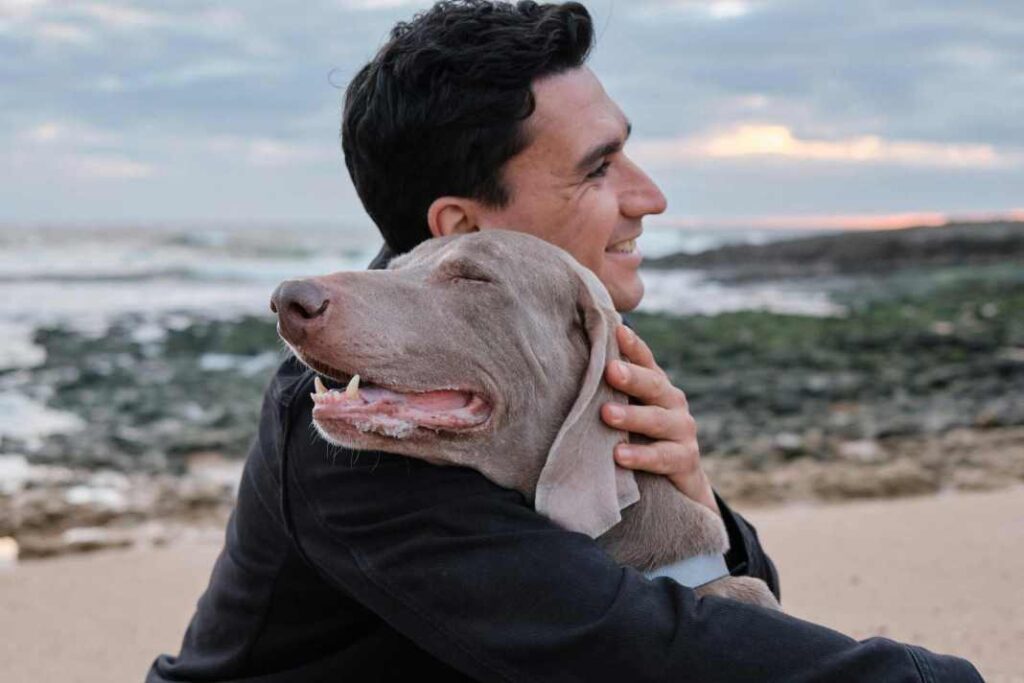What are effective ways to learn how to train a dog not to bark at strangers?
Effective methods on how to train a dog not to bark at strangers include positive reinforcement, desensitization by gradually exposing them to strangers, and redirecting their focus with toys or treats. These techniques, and more, are covered below.
Consistency, patience, and praise for good behavior are key to successfully modifying this behavior.
Key Highlights
- Learn effective ways how to train a dog not to bark at strangers, such as using the “quiet” command and positive reinforcement.
- Lack of socialization and proper training can contribute to dogs barking at strangers.
- Professional dog trainers can provide valuable techniques and guidance in training your dog.
- Distractions and desensitization methods can help manage and reduce barking behavior.
- Consistency in training and implementing positive reinforcement are key to successful outcomes.
Cut to the chase: Online Dog Training for Barking Dogs – 3-Day Trial for only $1.00!
Introduction: How to Train a Dog Not to Bark at Strangers
It is totally normal for dogs to bark, but it can also be a nuisance, especially when they bark excessively around strangers. As much as you want to show others how friendly they are, and how well they behave when it’s just the two of you playing and training, your dog may not cooperate and start scaring new people away when you’re in public or you have visitors come to your home.
Once they experience barking as an effective way to drive people away, they’ll start doing it every time a stranger is in your house or when they see someone outside. You want to break this habit as early as possible– behaviorist methods and bark collars are both effective ways to train your dog not to bark at strangers. But before you try to break any habit, it’s best if you understand why they do it in the first place. Here are 4 reasons why your dog barks at strangers.
Understanding Why Dogs Bark at Strangers
Why Your Dog Will Bark at Strangers
They’re being territorial
Observe your dog’s body language. If they’re stiff with their hackles raised whenever a stranger or a new dog passes by your house or yard, it’s a clear sign that they’re protecting their territory. Dogs are extremely protective of their home and their humans, and this means your dog sees strangers as potential threats, especially when they approach the front door. Having a territorial dog, ready to protect you from a threat, can be good for security, but isn’t good if they are overly territorial as they can become aggressive.
They’re excited
If your dog is barking at strangers with a wagging tail and wiggly butt, it’s likely that they’re simply excited or overcome with joy. Dogs often bark at strangers because they are overly excited. Puppies do this more often, and it’s typically not dangerous. Although this type of barking shows how much your dog loves humans, it sometimes catches people off guard and can make them fearful if they don’t know your dog.
They lack human socialization
It’s possible that your dog barks because they are uncomfortable with new people, especially if they didn’t have enough human interaction when they were puppies. Unsocialized dogs tend to bark at all strangers. Rescue dogs also bark this way when human interaction is not frequent. In addition, dogs tend to bark if they have a bad experience with their previous owners, which affects their capacity to trust new people. This type of barking is linked to overwhelming anxiety.
They’re afraid
Lack of socialization with people or other dogs leads to this fear of the unknown. This can drive your dog to bark or howl at any unexpected people. If your dog is afraid of other animals and humans, you may expect them to bark at any visitors that approach you or your house.

The Instinct of Territorial Protection
One of the main reasons why dogs bark at strangers is because of their instinctual need to protect their territory. Dogs are inherently loyal and will instinctively protect their home and humans, and they may see strangers as potential threats. This territorial barking is their way of alerting their owners to the presence of an unknown person or animal in their space.
Territorial barking can be a desirable trait in certain situations, such as having a guard dog to protect your property. However, excessive territorial barking can become a nuisance and cause distress to both the dog and the people around them. It’s important to address this behavior and train your dog to differentiate between actual threats and harmless strangers.
Implementing training techniques that focus on desensitization and positive reinforcement can help your dog learn to distinguish between normal visitors and potential intruders. By gradually exposing your dog, in a controlled manner, to situations where they encounter strangers, you can help them develop a more balanced response and reduce excessive territorial barking.
Fear and Anxiety as Triggers
Fear and anxiety are common triggers for dogs to bark at strangers. Dogs who have not been properly socialized or have had negative experiences with people in the past may develop a fear response when encountering unfamiliar individuals.
This fear of the unknown can manifest as barking or howling, as this is a way for the dog to communicate its discomfort and attempt to ward off potential threats. Additionally, loud noises or sudden movements from strangers can further escalate a reactive dog’s fear response, leading to increased barking.
To address this behavior, it is important to gradually expose your dog to new people and situations in a controlled and positive manner. This process, known as desensitization and counter-conditioning, involves slowly increasing your dog’s comfort level through gradual exposure and positive reinforcement.
My article How To Help Overcome Fear will be helpful if you think anxiety and fear are the reason your dog barks at strangers.
Working with a professional dog trainer can be beneficial in developing a customized training plan to help your dog overcome their fear and anxiety. By creating a positive association with strangers and providing your dog with alternative coping mechanisms, you can help reduce their barking behavior and promote a sense of security.
Lack of Proper Socialization
A lack of proper socialization during a dog’s critical developmental period can contribute to their tendency to bark at strangers. Socialization involves exposing a dog to a variety of people, animals, and environments to ensure they become comfortable and confident in different situations.
Dogs who have not had enough positive experiences with new people may bark because they are excited, fearful or simply because they don’t realize it is inappropriate for them to do so. This lack of socialization can be a result of previous owners not providing the necessary exposure to social situations, or if a rescue dog has come from an environment with limited human interaction. Many owners simply don’t know where to start or have any insight about how to train a dog not to bark at strangers.
To address this issue, your dog needs to be introduced to social situations, where it experiences new people and environments, and where it can learn how to behave appropriately. The first step towards proper socialization can be achieved by starting with low-stress situations and gradually increasing the level of exposure over time.
My article Socialization Tips for Your Growing Puppy will be helpful if you think proper socialization is the cause of your dog barking at strangers.
Rewarding your dog for calm behavior and providing positive reinforcement will help your dog have a positive association with being in a social situation. Consistency and patience are key.
Online Dog Training for Barking Dogs – 3-Day Trial for only $1.00!
Essential Training Techniques To Reduce Or Stop Barking
Once you understand the drivers behind their barking, you have a basis on which to train your dog not to bark at strangers, and start to correct this behavior.
Remember that barking is a natural instinct for dogs, so while there are successful strategies that show you how to train a dog not to bark at strangers, don’t expect to see results right away. Be patient.
Here are some tips and techniques that you can use to train your dog to be stranger-friendly.
Distract Them
You can train your dog to quit barking by distracting them. Once your dog starts barking, use noise to distract them. For example, you may do this by clicking, snapping your fingers, or even by jangling your keys. When they stop barking and are paying attention to you, tell them to sit and remain calm.
If you’re in public, like when you’re taking a walk, and they start barking at someone, distract them by walking in the opposite direction of the passersby. This diverts their attention and avoids the chance of interaction that can cause them to bark more.
Teach Them the “Quiet” Command
Training your dog to be quiet on command can be a valuable tool in curbing excessive barking. The “quiet” command involves your dog learning not to bark when told to stay quiet.
Most dogs will need to be taught what the command means, so the following steps to teach them what is expected when you use the “quiet” command:
- Lightly hold their muzzle and say, “Quiet”. Make sure they have had obedience training or this command won’t work, and avoid yelling it, as that produces negative reinforcement.
- Once they stop barking, take your hands off their muzzle
- If they remain quiet, reward them with a treat
- Repeat the procedure if they start barking again, rewarding them each time they stop. Increase the intervals between giving rewards so that the command can take effect.
My article Effective Solutions for Quieting Your Dog is a great guide to anti-barking devices.
Tip: You can try this strategy without holding your dog’s muzzle if doing so creates frustration or uncooperative behavior. Instead, calmly use your “quiet” command, and then distract them from the stranger by offering them a reward or something to munch on, such as a small piece of chicken.
Send Them to Their “Spot”
If your dog frequently barks at strangers when you are in your house, sending them to their special spot is a technique that can work very well to distract or stop them.
Firstly, choose a spot in your house where your dog will feel safe and comfortable when visitors come.
Then, train them to go to their spot, noting that they need to have had obedience training for this trick to work. The steps to train them to go to their spot are:
- Start by saying “go to your spot”.
- Then throw a treat in its direction.
- Repeat this process about ten times.
- As soon as your dog grasps this idea, you may use the command while acting as though you are throwing a reward in the direction of the target.
- To provide positive reinforcement, you can then give them the treat if they comply.
- The next step is to educate your dog to go to its location from various areas of the house.
At the beginning of the training, don’t forget to praise them whenever they follow your instructions, and in time they will be happy to go to their spot any time you tell them to.
Preventive Measures
Using preventive measures limits your dog from interacting with others, and can be particularly useful if they must remain inside or outside without your supervision.
Preventative methods to limit your dog’s interactions include:
- Close curtains and windows to block their vision. This way, they can’t see any strangers and have no reason to bark. For instance, if you are expecting a parcel, you can keep your curtains drawn at home.
- Install a tall fence made of an opaque material to limit your dog’s ability to see past your yard and prevent barking.
- Keep your dog from hearing noises from outside the room by having a television playing, or providing white noise.
- Provide an area away from guests. Make sure your dog has a quiet space to relax that is away from busy areas of the house where you might be entertaining guests.
- Avoid unplanned meetings. Try to know ahead of time when a visitor could drop by so that your dog can be prepared and won’t get a surprise or fright.
Desensitization and Counter-conditioning
One effective training technique for curbing barking behavior in dogs is desensitization and counter-conditioning. This method involves gradually exposing your dog to the presence of strangers in a controlled and positive manner, allowing them to become more comfortable and less reactive over time.
Working with a professional dog trainer can be beneficial in developing a desensitization and counter-conditioning plan tailored to your dog’s specific needs. The trainer can guide you in creating a step-by-step training program that gradually introduces your dog to strangers while providing positive reinforcement for calm behavior.
During the training sessions, your dog will be exposed to strangers at a distance that does not trigger excessive barking. As your dog remains calm and maintains eye contact with you, they will be rewarded with treats and praise. Over time, the distance between your dog and the strangers can be gradually decreased, allowing your dog to become more accustomed to their presence without becoming anxious or reactive. This process, known as desensitization and counter-conditioning, is an effective way to train a dog not to bark at strangers.
Desensitization and counter-conditioning can help your dog develop a more positive association with strangers and reduce their instinct to bark. This training technique requires consistency and patience, but with time and practice, you can help your dog overcome their barking behavior and become more comfortable around unfamiliar people.
The Use of Distractions to Manage Barking
Another effective technique to manage and reduce barking behavior in dogs is the use of distractions. When your dog starts barking at a stranger, you can redirect their attention using noise or other stimuli to break their focus on the person.
One simple distraction method is to use noise, such as clicking, snapping, or jangling your keys. The sudden sound can startle your dog and redirect their attention away from the stranger. It’s important to pair this distraction with a command, such as “sit” or “stay,” to encourage calm behavior.
If you’re in a public setting and your dog starts barking at someone, you can also divert their attention by walking in the opposite direction of the passersby. This not only distracts your dog but also prevents any further interaction that may trigger more barking.
Using distractions to manage barking requires consistent training and reinforcement. By redirecting your dog’s attention away from strangers and rewarding them for calm behavior, you can help them develop alternative responses to unfamiliar people and reduce excessive barking.
Obedience Training
If you are still wondering how to train a dog not to bark at strangers, then you may want to start with obedience training. As mentioned above this is a foundation for stopping your dog from barking at strangers.
Obedience Training helps them follow your commands at all times, even whenever a stranger is around or they are scared and anxious. Obedience training is not just for police dogs, every dog will benefit from it.
I recommend that you read my article Proven Obedience Training Strategies for Dogs which I think will be useful not only for training your dog not to bark at strangers, but many other dog obedience issues as well.
Online Dog Training for Barking Dogs – 3-Day Trial for only $1.00!
Consistency Of Positive Reinforcement
Positive Reinforcement
Positive reinforcement of the desired behaviors is a crucial aspect in training your dog not to bark at strangers. It involves rewarding your dog for good behavior, thereby encouraging them to repeat that behavior in the future.
When your dog stops barking at strangers when commanded or remains calm in their presence, it’s important to reward them with treats, verbal praise, or petting. This positive reinforcement helps your dog associate quiet and calm behavior with positive outcomes, reinforcing the desired behavior.
Positive reinforcement helps your dog associate quietness with good behavior and pleasant outcomes. By consistently implementing positive reinforcement, you can reinforce the message that it is safe and rewarding to remain calm around strangers.
Using high-value treats such as a small piece of chicken or their favorite snack, can be particularly effective in grabbing your dog’s attention and motivating them to continue exhibiting good behavior.
You may want to read my article Optimizing Treats and Praise for Dog Training to learn how to effectively use treats and praise in reward-based training to encourage desired behaviors in dogs and build a strong bond between you and your furry friend.
How Consistency Enhances Training Outcomes
Dogs thrive on routine and depend on clear and consistent communication from their owners. Consistency in your approach to training is essential. If you are inconsistent your dog will get confused and won’t understand what you expect from it.
Consistent training involves setting clear expectations and following through with them daily. This includes incorporating training exercises into your daily routine and involving all family members in the training process. When everyone in the household consistently reinforces the same commands and behavior expectations, it creates a cohesive training environment for your dog.
Consistency also applies to the use of positive reinforcement and rewards. By consistently rewarding your dog for good behavior and being patient with their progress, you can reinforce the desired response and encourage them to continue exhibiting calm behavior around strangers. Make sure to provide rewards immediately after the desired behavior is exhibited, as this helps your dog understand the connection between their actions and the reward.
By maintaining consistency in your training approach, you can maximize the effectiveness of your efforts and help your dog learn not to bark at strangers more quickly and efficiently.
Advanced Training Strategies
In some cases, advanced training strategies may be necessary to effectively address and manage barking behavior in dogs. Working with a professional dog trainer can provide valuable guidance and expertise in implementing these strategies.
One advanced training strategy is setting up controlled greeting scenarios. This is an advanced training strategy that can help your dog develop appropriate social skills and reduce barking behavior in unfamiliar situations. This technique involves gradually exposing your dog to controlled interactions with strangers in a positive and controlled environment.
Setting up a controlled greeting scenario:
- Begin by selecting individuals who are comfortable and knowledgeable about dog behavior to participate in these scenarios.
- Ensure that the environment is calm and controlled, with minimal distractions.
- Start at a distance where your dog remains calm and gradually decrease the distance as your dog becomes more comfortable.
- During these controlled greetings, instruct the strangers to ignore your dog initially and allow your dog to approach them at their own pace.
- Reward your dog for calm and appropriate behavior, such as sitting or remaining calm in the presence of a stranger.
- Over time, your dog will learn to associate meeting new people with positive experiences and reduce their instinct to bark.
If you find it challenging to train your dog, or it isn’t learning as well as you would like, then a professional dog trainer can help you.
Professional dog trainers not only know how to train a dog not to bark at strangers, but they can also provide advanced training strategies tailored to your dog’s specific needs. Their expertise and experience can greatly enhance the effectiveness of your training efforts and help you achieve the desired outcome more quickly.
Equipment That Can Aid in Training
Various types of training equipment can aid in training your dog not to bark at strangers. These tools can provide additional support and reinforcement to help modify your dog’s behavior.
The two most commonly used training tools are:
- Training harnesses: These can be effective in managing barking behavior. These harnesses have a front clip that allows you to redirect your dog’s attention and encourage calm behavior.
- Bark collars: A bark collar can emit a harmless spray or vibration when your dog barks excessively. This negative reinforcement can help deter barking and reinforce the command to be quiet.
It’s important to note that while training equipment can be useful, it should always be used in conjunction with consistent training and positive reinforcement.
The equipment is meant to augment your training efforts, not replace them. By combining training equipment with positive reinforcement and consistent training, you can effectively address barking behavior in your dog.
Conclusion
Learning how to train a dog not to bark at strangers requires patience, consistency, and positive reinforcement. Three main steps are:
- Firstly understanding why dogs bark and address those triggers through proper training techniques is key.
- If needed, also implementing desensitization methods
- Finally, consider advanced strategies such as controlled greetings to further enhance the training process.
Remember, every dog is unique, so tailor your approach accordingly to achieve successful results in managing and reducing barking behaviors both at home and in public settings.
Online Dog Training for Barking Dogs – 3-Day Trial for only $1.00!
Frequently Asked Questions
What to Do if Your Dog Relapses in Behavior?
If your dog relapses in their barking behavior, it maybe because it has forgotten what is expected. You need to re-introduce the training techniques, be consistent and provide positive reinforcement.
Consider seeking the assistance of a professional dog trainer. They can help address any underlying issues and provide advanced training strategies tailored to your dog’s specific needs
How Long Does It Take to Train a Dog Not to Bark at Strangers?
The amount of time it takes to train a dog not to bark at strangers can vary depending on many factors, including the dog’s breed, previous training, and individual temperament.
Positive reinforcement, along with regular training sessions, are key to achieving desired results. It may take several weeks or months, especially for rescue dogs or those with ingrained barking behavior, but with patience and persistence, progress can be made.
Are Some Breeds More Prone to Barking at Strangers?
Certain dog breeds may be more prone to barking at strangers due to their natural tendencies. Breeds such as German Shepherds and Terriers are known for their guard dog instincts and territorial barking. However, it’s important to note that individual temperament and training play a significant role in a dog’s behavior. Regardless of breed, consistent training can help reduce barking behavior in all dogs.
Can Old Dogs Learn Not to Bark at Strangers?
Old dogs can certainly learn new behaviors, including not barking at strangers. While it may take more time and patience to train an older dog, consistency and patience on your part can help train them to develop new habits and reduce barking behavior.
Gentle Training Solutions: The BarX Stop Review

BarX Stop: A handheld anti-barking device that uses ultrasonic sound and a bright flashlight to train dogs and deter unwanted behaviors, offering a safe and humane alternative to shock collars and sprays.
Continue reading: The BarX Stop Review
Effective Solutions for Quieting Your Dog: A Guide to Anti-Barking Devices

Choose the Most Effective Solutions for Quieting Your Dog: An overview of ultrasonic bark deterrents, vibration collars, and spray collars, along with tips for successful use and addressing neighbor concerns.
Continue reading: A Guide to Anti-Barking Devices




